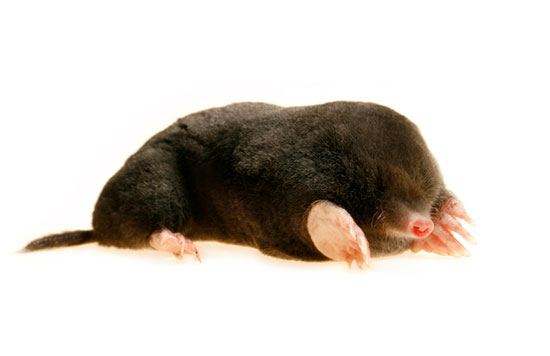Below are the top questions we are asked repeatedly about moles, so we have put together a quickfire guide to answer everything you need to know about moles.
- Why do I have new activity after a mole has already been caught?
- Why do mole hills keep reoccurring in the same position?
- How do I get rid of moles for good?
Meet the Mole

Firstly, it must be understood that moles are primarily solo survivors (until in comes to mating season, of course). They produce the molehills which can leave a rather big mess in your garden if not dealt with. The molehills are produced when moles are burrowing their underground network of tunnels and looking for tasty worms to feed on. Moles are particularly busy in the rainy months, taking advantage of the wet soil.
How do I know if I have a mole problem.
We get called out to a range of sizes of infestations from farmers’ fields with loads of activity to small garden properties where there will be just one patch of mole hills. No matter what the size of your problem area we have experience and solutions to help you get rid.
The area that one mole can cover really varies, but usually if lots of mole hills are located closely together then this means you’ll likely only have one mole to deal with (although this can’t be guaranteed)
Will Moles just go away?
We cannot say for certain either way, they might go naturally, or they might continue to tear up your garden who knows! The best course of action is to use trapping. This is the most effective way to rid you of your mole problem. Although there are other options on the market for mole prevention, they each have their downfalls. One being deterrent devices, these devices do not work in the long term and moles have become accustomed to them, a lot of the mole problems we treat have these devices and usually the mole is tunnelling right next to them. Another way is humane trapping, if you are attempting or thinking about trapping the mole humanely, don’t be surprised when the mole comes back to its tunnels on your property.
How we deal with moles
We have vast experience and consider ourselves experts when it comes to catching moles. When dealing with a mole infestation of any size we deploy a trapping method.
- We arrive at your property and survey the area.
- We set around 5 traps per area of mole activity that we suspect, these traps will be covered underground along with flag markers to ensure everyone knows where the traps are set.
- The traps are left for several days (we aim to return within 5 days of setting)
- All being well we have caught the mole and the job is complete however this is sometimes not the case
- If we suspect more activity or failure to catch the mole first time round, we repeat this process until you are mole free!
Will I get a mole problem again?
If you notice that mole hills on your property keep occurring in the same place there is a reason behind this and not just ongoing bad luck!
Once a mole problem has been dealt with and the mole is removed from the problem area it leaves behind it’s carefully formed underground network of tunnels. Naturally with the tunnels vacated this spot is easy picking for any other mole that comes across the tunnels, with the hard work already done for them. We use the analogy that its like a for sale sign goes up outside a house and inevitably someone new will move in.
Summary
Moles can be a frustrating pest to deal with and can cause havoc on your property if left or not dealt with professionally. The best course of action to take when you suspect a mole problem is to give us a call on 01635 250 852 and let us deal with your mole problem safely and efficiently.
Did you find this article useful/ helpful/ interesting? Perhaps you know someone who would enjoy reading it?
Here's the full link:- https://www.pestcontrolberkshire.com/blog/how-to-stop-moles-ruining-your-property
.png?updated=1615563570)